179 The Royal Dog of Scotland-the Deerhound
THE DEERHOUND: ROYAL DOG OF SCOTLAND
by David Hancock
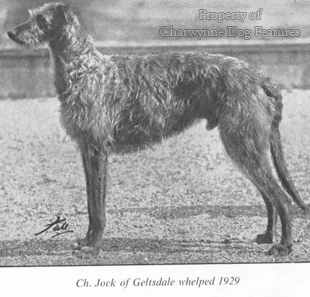 "3,000 men of the Fian, each with two hounds, were involved. Finn arranged the hounds on the east and west and the dogs' barking raised boar and deer from the hill. Fian and his dog Bran waited seated on the mountain, and every man was in his hunting position waiting for the deer. 3,000 hounds were unleashed and 6,000 deer were killed." This quotation from 'Hunting and Hunting Reserves in Medieval Scotland' by John Gilbert gives some idea of the scale of hunting in Scotland in those times. We also know that Scottish greyhounds, (not called Deerhounds until the early 19th century), were renowned in the Roman Empire and throughout medieval Europe. If Scottish nationalists ever need a mascot, here's a worthy one. Robust dogs, seemingly free of the now common congenital diseases besetting so many pedigree dogs, their blood is prized by knowledgeable lurcher men. I have a colleague who is a sheep farmer in a remote area and he uses a brace to kill foxes. He is most impressed by their hunting skills and quite remarkable facility for detecting movement over huge distances. They can track as well as hunt by sight. Some breeds have changed in the hands of show breeders but this breed seems to have retained their essential type over several centuries. It is quite astonishing that so very few books have been written about such an ancient breed with so much intrinsic merit. It is easy to ove
"3,000 men of the Fian, each with two hounds, were involved. Finn arranged the hounds on the east and west and the dogs' barking raised boar and deer from the hill. Fian and his dog Bran waited seated on the mountain, and every man was in his hunting position waiting for the deer. 3,000 hounds were unleashed and 6,000 deer were killed." This quotation from 'Hunting and Hunting Reserves in Medieval Scotland' by John Gilbert gives some idea of the scale of hunting in Scotland in those times. We also know that Scottish greyhounds, (not called Deerhounds until the early 19th century), were renowned in the Roman Empire and throughout medieval Europe. If Scottish nationalists ever need a mascot, here's a worthy one. Robust dogs, seemingly free of the now common congenital diseases besetting so many pedigree dogs, their blood is prized by knowledgeable lurcher men. I have a colleague who is a sheep farmer in a remote area and he uses a brace to kill foxes. He is most impressed by their hunting skills and quite remarkable facility for detecting movement over huge distances. They can track as well as hunt by sight. Some breeds have changed in the hands of show breeders but this breed seems to have retained their essential type over several centuries. It is quite astonishing that so very few books have been written about such an ancient breed with so much intrinsic merit. It is easy to ove rlook the value of hounds which could hunt red deer successfully before the wide use of long range firearms. In a harsh winter the skill of such a dog could mean the difference between starvation and survival for the primitive hunters. Once this value diminished however, these huge shaggy fast-running hounds fell on hard times, surviving only in some areas through the patronage of the nobility. Pennant recorded, when visiting Scotland in 1769, that he saw at Gordon castle true Highland greyhounds which had become very scarce. He described these hounds as "of large size, strong, deep-chested, and covered with very long and rough hair", used "in large numbers at the magnificent stag chases by the powerful chieftains." Lurcher men, keepers and stalkers refer to them as staghounds to this day. The Earl de Folcoville had his noted Colonsay strain in the first half of the 19th century. MacNeile, in his chapter on deerhounds, the first detailed write-up of the breed, in Scrope's book on deerstalking of 1838, described "Buskar", one of the purest specimens, as 28" at the shoulder, with a chest girth of 32", weighing 85lbs,going on to write: "This dog is of pale yellow, and appears to beremarkably pure in his breeding, not only from his shape and colour,
rlook the value of hounds which could hunt red deer successfully before the wide use of long range firearms. In a harsh winter the skill of such a dog could mean the difference between starvation and survival for the primitive hunters. Once this value diminished however, these huge shaggy fast-running hounds fell on hard times, surviving only in some areas through the patronage of the nobility. Pennant recorded, when visiting Scotland in 1769, that he saw at Gordon castle true Highland greyhounds which had become very scarce. He described these hounds as "of large size, strong, deep-chested, and covered with very long and rough hair", used "in large numbers at the magnificent stag chases by the powerful chieftains." Lurcher men, keepers and stalkers refer to them as staghounds to this day. The Earl de Folcoville had his noted Colonsay strain in the first half of the 19th century. MacNeile, in his chapter on deerhounds, the first detailed write-up of the breed, in Scrope's book on deerstalking of 1838, described "Buskar", one of the purest specimens, as 28" at the shoulder, with a chest girth of 32", weighing 85lbs,going on to write: "This dog is of pale yellow, and appears to beremarkably pure in his breeding, not only from his shape and colour, but from the strength and wiry elasticity of his hair, which by Highlanders is thought to be a criterion of breeding." MacNeile stated that the grey dogs appeared to be "less lively and did not exhibit such a development of muscle, particularly on the back and loins, and have a tendency to cat hams". Dark grey deerhounds prevailed in the Highlands but MacNeile refers to sandy-red and pale yellow dogs too. Youatt, writing in 1845, describes the Highland greyhound or deerhound as being 2" taller than the Scottish greyhound. "Stonehenge" in his book of 1867 places the deerhound with the retrievers! A writer in Dalziel's book of 1879 stated that the best bred ones always had the flaps of the ears turned a little outwards, so you could see inside the ear, adding that he always doubted the purity of a deerhound with a head narrow between the ears. In 1880, Captain Graham, who re-created the Irish wolfhound, told of the oldest recorded deerhound strain being with the Menzies of Loch Tay, having been kept pure for just about 100 years. The classic use of deerhounds involves a brace coursing their quarry and killing it unaided. This demands not just speed, strength and stamina but superbly constructed dogs, whose limbs and, especially, feet can cope with boulder-strewn terrain at great speed, whose joints can withstand fierce jarring and whose physique combines great power with lightness of build. The first point my eye seeks out in a walking deerhound, even in a show ring, is a noticeable springiness of step and "daisy-clipping" action in the feet; for me all other
but from the strength and wiry elasticity of his hair, which by Highlanders is thought to be a criterion of breeding." MacNeile stated that the grey dogs appeared to be "less lively and did not exhibit such a development of muscle, particularly on the back and loins, and have a tendency to cat hams". Dark grey deerhounds prevailed in the Highlands but MacNeile refers to sandy-red and pale yellow dogs too. Youatt, writing in 1845, describes the Highland greyhound or deerhound as being 2" taller than the Scottish greyhound. "Stonehenge" in his book of 1867 places the deerhound with the retrievers! A writer in Dalziel's book of 1879 stated that the best bred ones always had the flaps of the ears turned a little outwards, so you could see inside the ear, adding that he always doubted the purity of a deerhound with a head narrow between the ears. In 1880, Captain Graham, who re-created the Irish wolfhound, told of the oldest recorded deerhound strain being with the Menzies of Loch Tay, having been kept pure for just about 100 years. The classic use of deerhounds involves a brace coursing their quarry and killing it unaided. This demands not just speed, strength and stamina but superbly constructed dogs, whose limbs and, especially, feet can cope with boulder-strewn terrain at great speed, whose joints can withstand fierce jarring and whose physique combines great power with lightness of build. The first point my eye seeks out in a walking deerhound, even in a show ring, is a noticeable springiness of step and "daisy-clipping" action in the feet; for me all other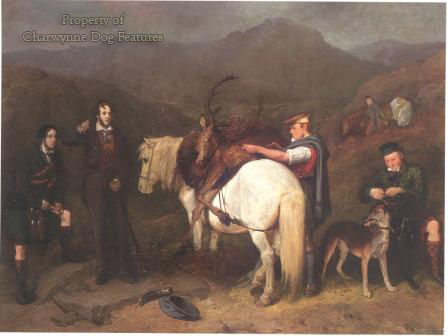 points are subordinate to this essential feature. Rough-coated hunting dogs have been known in Scotland for over a thousand years. The Celts were famous for their coarse-haired running dogs, both trackers and gazehounds. Celtic expansion along the main river routes in central Europe led to settlements being established by 200BC from northern Spain in the west to Hungary in the east and from the British Isles in the north to the Adriatic in the south. It is significant that coarse-haired hunting dogs are found wherever they settled: the griffon hound breeds of France, the rough-haired Styrian hounds of Austria, the wolfhound of Ireland, the spinone of Italy, the wire-haired pointing griffons of Hungary, Germany and Czechoslovakia and many of the terrier breeds, perhaps influencing the rough-haired segugio of Italy and the Bosnian hound too. Conrad Heresbach, writing in a book published in Cologne in 1570 on rural sports, delivered these words on hunting dogs: "We have seen some brought from Norway and the Island of Thule of uncommon speed which in tail and body were quite rough-haired...Of this kind are the British, valued for speed as well as strength, except that by their big body they are more suitable for chasing the stag." At the end of the 16th century, James VI sent ten of these rough-haired "staghounds" to the King of Denmark as a gift, with a further nine subsequently. Two hundred years later in Thomas Bewick's "General History of Quadrupeds" we can find these words: "Next to this" (i.e. the Irish 'greyhound') "in size and strength is : the Scottish Highland Greyhound or Wolf-dog; which was formerly used by chieftains of that country in their grand hunting parties. One of them, which we saw some years ago, was a large powerful fierce-looking
points are subordinate to this essential feature. Rough-coated hunting dogs have been known in Scotland for over a thousand years. The Celts were famous for their coarse-haired running dogs, both trackers and gazehounds. Celtic expansion along the main river routes in central Europe led to settlements being established by 200BC from northern Spain in the west to Hungary in the east and from the British Isles in the north to the Adriatic in the south. It is significant that coarse-haired hunting dogs are found wherever they settled: the griffon hound breeds of France, the rough-haired Styrian hounds of Austria, the wolfhound of Ireland, the spinone of Italy, the wire-haired pointing griffons of Hungary, Germany and Czechoslovakia and many of the terrier breeds, perhaps influencing the rough-haired segugio of Italy and the Bosnian hound too. Conrad Heresbach, writing in a book published in Cologne in 1570 on rural sports, delivered these words on hunting dogs: "We have seen some brought from Norway and the Island of Thule of uncommon speed which in tail and body were quite rough-haired...Of this kind are the British, valued for speed as well as strength, except that by their big body they are more suitable for chasing the stag." At the end of the 16th century, James VI sent ten of these rough-haired "staghounds" to the King of Denmark as a gift, with a further nine subsequently. Two hundred years later in Thomas Bewick's "General History of Quadrupeds" we can find these words: "Next to this" (i.e. the Irish 'greyhound') "in size and strength is : the Scottish Highland Greyhound or Wolf-dog; which was formerly used by chieftains of that country in their grand hunting parties. One of them, which we saw some years ago, was a large powerful fierce-looking 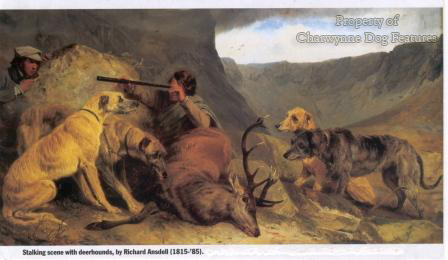 dog; its ears were pendulous and its eyes half hid in its hair; its body was strong and muscular, and covered with harsh wiry reddish hair, mixed with white." I haven't seen this red coat colouration for many many years but I have seen some fine blue-grey specimens down the years, especially from the Ardkinglas, Geltsdale and Rotherwood kennels. I get depressed when I see deerhounds in the show ring with woolly coats, poor feet and no spring in their gait, lacking leg muscle and depth of chest. This breed is descended from a primitive hunting dog, prized for its field prowess, famed for its strength and speed and essentially a functional animal. I get concerned too about deerhounds being bred for great size at the expense of soundness; for the breed standard to stipulate a minimum height of 30" at the withers for dogs and 28" for bitches, with no mention of soundness first and foremost, is to my mind, unwise. In a pedigree breed with a closed gene pool a loss of stature becomes increasingly likely with each decade. I would much rather have an overall sound dog of 28" at the withers than an oversized unsound dog. An inch or two in s
dog; its ears were pendulous and its eyes half hid in its hair; its body was strong and muscular, and covered with harsh wiry reddish hair, mixed with white." I haven't seen this red coat colouration for many many years but I have seen some fine blue-grey specimens down the years, especially from the Ardkinglas, Geltsdale and Rotherwood kennels. I get depressed when I see deerhounds in the show ring with woolly coats, poor feet and no spring in their gait, lacking leg muscle and depth of chest. This breed is descended from a primitive hunting dog, prized for its field prowess, famed for its strength and speed and essentially a functional animal. I get concerned too about deerhounds being bred for great size at the expense of soundness; for the breed standard to stipulate a minimum height of 30" at the withers for dogs and 28" for bitches, with no mention of soundness first and foremost, is to my mind, unwise. In a pedigree breed with a closed gene pool a loss of stature becomes increasingly likely with each decade. I would much rather have an overall sound dog of 28" at the withers than an oversized unsound dog. An inch or two in s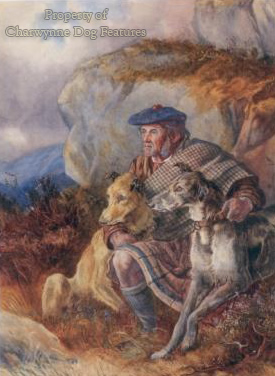 tature can never match the overall soundness so essential in a hunting dog. Deerhound blood has been utilised not just by lurcher men in Britain but by their opposite numbers hunting coyotes in America and kangaroo in Australia. Such breeders are seeking all round hunting skills: a good nose, coursing ability and the keen determination to pursue a fast quarry over some distance. The deerhound is considered to be the brightest of the "longdogs", some say handed down from the collie blood used many years ago. But just as deerhound blood is of value in outcrosses, so too may , for example, greyhound blood be needed once again in the deerhound breed, for the genetic base is small. Pure breeding is fine when things are going well but disastrous when inbred faults such as weak hindquarters are being perpetuated. Deerhounds are, with foreign breeds like the Schipperke and the Elkhound and native breeds like the Border terrier and the foxhound, one of the few modern breeds to remain true to their original type. They are undoubtedly bred more uniformly nowadays, but without functional tests, who knows how sound they are under those shaggycoats? The showring is no place to verify physical
tature can never match the overall soundness so essential in a hunting dog. Deerhound blood has been utilised not just by lurcher men in Britain but by their opposite numbers hunting coyotes in America and kangaroo in Australia. Such breeders are seeking all round hunting skills: a good nose, coursing ability and the keen determination to pursue a fast quarry over some distance. The deerhound is considered to be the brightest of the "longdogs", some say handed down from the collie blood used many years ago. But just as deerhound blood is of value in outcrosses, so too may , for example, greyhound blood be needed once again in the deerhound breed, for the genetic base is small. Pure breeding is fine when things are going well but disastrous when inbred faults such as weak hindquarters are being perpetuated. Deerhounds are, with foreign breeds like the Schipperke and the Elkhound and native breeds like the Border terrier and the foxhound, one of the few modern breeds to remain true to their original type. They are undoubtedly bred more uniformly nowadays, but without functional tests, who knows how sound they are under those shaggycoats? The showring is no place to verify physical 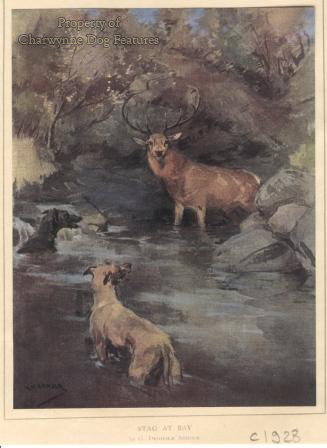 soundness and few conformation show judges in these times seem to know how to assess sporting dogs. All too often they seem to judge on faults not merits. It islikely that the deerhound has retained its essential type because it seems to attract distinguished owners and breeders. Names likeMiss Doxford of the Ruritania kennel, the Misses Loughrey of the Ross kennel, Miss Bell of the Enterkine kennels, Miss Linton (Geltsdale), Miss Hartley (Rotherwood) and Miss Noble (Ardkinglas) would grace any breed club register. But I do see, mainly over the last five years or so, far too many deerhounds in a new mould: small, woolly-coated and light in bone, with sharp pointed heads and completely lacking the soft eye. Hounds like this are really without true type. Writing in his "Dogs of Scotland", published in 1891, Thomson Gray remarked that: "Another great drawback in connection with deerhounds is that they become small and weedy through interbreeding...all breeders will acknowledge that it is a serious one". Nobody wants the deerhound to have the narrow head of the borzoi or greyhound but if this pedigree breed does need an infusion of new blood there are some fine deerhound type lurchers around, although far too many of the latter are rather coarse-headed. It would be a major tragedy if this magnificent ancient breed were allowed to deteriorate; it is part of the heritage of Scotland and deserves to be preserved on pure merit. It would be both timely and very worthwhile if the landed families of Scotland today were to patronise this fine old breed, just as their predecessors did for so many centuries. No Scottish castle truly looks authentic without one!
soundness and few conformation show judges in these times seem to know how to assess sporting dogs. All too often they seem to judge on faults not merits. It islikely that the deerhound has retained its essential type because it seems to attract distinguished owners and breeders. Names likeMiss Doxford of the Ruritania kennel, the Misses Loughrey of the Ross kennel, Miss Bell of the Enterkine kennels, Miss Linton (Geltsdale), Miss Hartley (Rotherwood) and Miss Noble (Ardkinglas) would grace any breed club register. But I do see, mainly over the last five years or so, far too many deerhounds in a new mould: small, woolly-coated and light in bone, with sharp pointed heads and completely lacking the soft eye. Hounds like this are really without true type. Writing in his "Dogs of Scotland", published in 1891, Thomson Gray remarked that: "Another great drawback in connection with deerhounds is that they become small and weedy through interbreeding...all breeders will acknowledge that it is a serious one". Nobody wants the deerhound to have the narrow head of the borzoi or greyhound but if this pedigree breed does need an infusion of new blood there are some fine deerhound type lurchers around, although far too many of the latter are rather coarse-headed. It would be a major tragedy if this magnificent ancient breed were allowed to deteriorate; it is part of the heritage of Scotland and deserves to be preserved on pure merit. It would be both timely and very worthwhile if the landed families of Scotland today were to patronise this fine old breed, just as their predecessors did for so many centuries. No Scottish castle truly looks authentic without one!